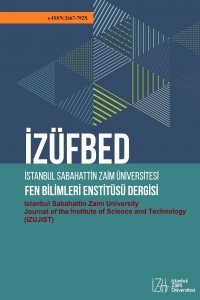Salgın Hastalıklarla Mücadelede Açık Kaynak Kodlu Çözümler
Corona, İstatistiksel Analizler, Sınıflandırma, Kümeleme, İlişkilendirme, Görüntü İşleme
Open Source Based Solutions in Combating Epidemics
___
- [1] Vaidyanathan, S., & Azar, A. T. (2016). Adaptive control and synchronization of Halvorsen circulant chaotic systems. In Advances in chaos theory and intelligent control (pp. 225-247). Springer, Cham.
- [2] Abdulmunem, A., A., Metip, M., H., & Abdulhussein, M., F. (2020). CORONA VIRUS DETECTION USING IMAGE SEGMENTATION TECHNIQUES. II. INTERNATIONAL CONFERENCE ON COVID-19 STUDIES. Erişim Tarihi 01.10.2020. URL: https://369485e5-78d9-4695-8ee7-77e624124993.filesusr.com/ugd/ 614b1f_28cb4d090c5143ec80b8d45876d24bd5 .pdf
- [3] Yıldırım, Ö., & Fındık O. (2020). DERİN ÖĞRENME YÖNTEMLERİ KULLANILARAK TÜRKİYE’DE COVID-19 YAYILIMI TAHMİNİ. II. INTERNATIONAL CONFERENCE ON COVID-19 STUDIES. Alınma Tarihi: 01/10/2020 URL: https://369485e5-78d9-4695-8ee7-77e624124993.filesusr.com/ugd/614b1f_ 0ef2c6d37e44437f8f66ee8cc185d 545.pdf
- [4] Randhawa, G. S., Soltysiak, M. P., El Roz, H., de Souza, C. P., Hill, K. A., & Kari, L. (2020). Machine learning using intrinsic genomic signatures for rapid classification of novel pathogens: COVID-19 case study. Plos one, 15(4), e0232391.
- [5] Elaziz, M. A., Hosny, K. M., Salah, A., Darwish, M. M., Lu, S., & Sahlol, A. T. (2020). New machine learning method for image-based diagnosis of COVID-19. Plos one, 15(6), e0235187.
- [6] Barstugan, M., Ozkaya, U., & Ozturk, S. (2020). Coronavirus (covid-19) classification using ct images by machine learning methods. arXiv preprint arXiv:2003.09424.
- [7] Tekerek, A. (2011). Veri madenciliği süreçleri ve açık kaynak kodlu veri madenciliği araçları. Akademik Bilişim, 11, 2-4.
- [8] Nesteruk, I. (2020). Statistics-based predictions of coronavirus epidemic spreading in mainland China.
- [9] Wikipedia. (2020). Alınma Tarihi: 20/12/2020 https://en.wikipedia.org/wiki/File:Turkey_total_COVID-19_cases_by_NUTS-1_regions.png
- [10] Sağlık Bakanlığı, (2020), https://covid19.saglik.gov.tr/, Alınma tarihi: 01/10/2020
- [11] Roser, M., Ritchie, H., Ortiz-Ospina, E., & Hasell, J. (2020). Coronavirus disease (COVID-19)–Statistics and research. Our World in data.
- [12] Pankowski, R., & Dzięgielewski, J. (2020). COVID-19 crisis and hate speech: Transnational report.
- [13] Sabic, I., Dodig, L., & Luić, L. (2020, November). COVID-19 IMPACT ON THE USE OF ICT TOOLS IN THE CROATIAN EDUCATION SYSTEM. In Proceedings of ICERI2020 Conference (Vol. 9, p. 10th).
- [14] Yadav, M., Perumal, M., & Srinivas, M. (2020). Analysis on novel coronavirus (COVID-19) using machine learning methods. Chaos, Solitons & Fractals, 139, 110050.
- [15] Sariman, G., & Mutaf, E. Covid-19 Süreci̇nde Twitter Mesajlarinin Duygu Anali̇zi̇.
- [16] Zhang, J., Xie, Y., Li, Y., Shen, C., & Xia, Y. (2020). Covid-19 screening on chest x-ray images using deep learning based anomaly detection. arXiv preprint arXiv:2003.12338.
- [17] Bulut, F. (2017). A new clinical decision support system with instance based ensemble classifiers. Journal of the Faculty of Engineering and Architecture of Gazi University, 32(1), 65-76.
- [18] Bütüner, R., & Calp, M. H. (2020). COVID-19 Detection from Lung Tomography Images Using Deep Learning and Machine Learning Methods (No. 4097).
- [19] Brunese, L., Mercaldo, F., Reginelli, A., & Santone, A. (2020). Explainable deep learning for pulmonary disease and coronavirus COVID-19 detection from X-rays. Computer Methods and Programs in Biomedicine, 196, 105608.
- [20] DEMİRCİOĞLU, M., & EŞİYOK, S. COVID–19 SALGINI İLE MÜCADELEDE KÜMELEME ANALİZİ İLE ÜLKELERİN SINIFLANDIRILMASI. İstanbul Ticaret Üniversitesi Sosyal Bilimler Dergisi, 19(37), 369-389.
- [21] Singhal, A., Singh, P., Lall, B., & Joshi, S. D. (2020). Modeling and prediction of COVID-19 pandemic using Gaussian mixture model. Chaos, Solitons & Fractals, 138, 110023.
- [22] Garufi, G., Carbognin, L., Orlandi, A., Tortora, G., & Bria, E. (2020). Smoking habit and hospitalization for severe acute respiratory syndrome coronavirus 2 (SARS-CoV-2)-related pneumonia: The unsolved paradox behind the evidence. European Journal of Internal Medicine.
- [23] Esper, F., Shapiro, E. D., Weibel, C., Ferguson, D., Landry, M. L., & Kahn, J. S. (2005). Association between a novel human coronavirus and Kawasaki disease. The Journal of infectious diseases, 191(4), 499-502.
- [24] Bonow, R. O., Fonarow, G. C., O’Gara, P. T., & Yancy, C. W. (2020). Association of coronavirus disease 2019 (COVID-19) with myocardial injury and mortality. JAMA cardiology.
- [25] Gozes, O., Frid-Adar, M., Sagie, N., Zhang, H., Ji, W., & Greenspan, H. (2020). Coronavirus detection and analysis on chest ct with deep learning. arXiv preprint arXiv:2004.02640.
- [26] Bhattacharya, S., Maddikunta, P. K. R., Pham, Q. V., Gadekallu, T. R., Chowdhary, C. L., Alazab, M., & Piran, M. J. (2020). Deep Learning and Medical Image Processing for Coronavirus (COVID-19) Pandemic: A Survey. Sustainable cities and society, 102589.
- [27] Afshar, P., Heidarian, S., Naderkhani, F., Oikonomou, A., Plataniotis, K. N., & Mohammadi, A. (2020). Covid-caps: A capsule network-based framework for identification of covid-19 cases from x-ray images. arXiv preprint arXiv:2004.02696.
- [28] Elaziz, M. A., Hosny, K. M., Salah, A., Darwish, M. M., Lu, S., & Sahlol, A. T. (2020). New machine learning method for image-based diagnosis of COVID-19. Plos one, 15(6), e0235187.
- Yayın Aralığı: Yılda 2 Sayı
- Başlangıç: 2019
- Yayıncı: İstanbul Sabahattin Zaim Üniversitesi
İnsani Yardım, Özgür ve Açık Kaynak Kodlu Yazılım Projeleri (İÖAKK)
Hıdır SELÇUK, T. Çetin AKINCI, Şahin Serhat ŞEKER
Karanlık Madde Etkin Alan Teorisinde Simülasyon Araçları Uygulamaları
Ayşe KUDAY, Erdinç SAKA, Ferhat ÖZOK
Özgür ve Açık Kaynak Kodlu Yazılım Platformlarının Uygulamalı Yapay Zeka Eğitimlerine Katkısı
Hıdır SELÇUK, T. Çetin AKINCI, Şahin Serhat ŞEKER
Salgın Hastalıklarla Mücadelede Açık Kaynak Kodlu Çözümler
Melike BEKTAŞ, Abdullah YAVUZ, Faruk BULUT
Veri Artırma Tekniklerinin Derin Öğrenmeye Dayalı Yüz Tanıma Sisteminde Etkisi
Erdal ALİMOVSKİ, Gökhan ERDEMİR
Bilgisayar Destekli Teknik Tasarım Dersleri için Açık Kaynak Kodlu Müfredat Önerisi
Fahri Anıl SELÇUK, Aydın Tarık ZENGİN
Hıdır SELÇUK, T. Çetin AKINCI, Şahin Serhat ŞEKER
Özgür Yazılım ve Açık Kaynağın Güncel Kullanımına Örnekler ve Durum İncelemesi
Elif AŞICI, Aydın Tarık ZENGİN
Kurumsal Yerel Ağ Üzerinde Merkezi IP Telefon Santrali Kurulumu
